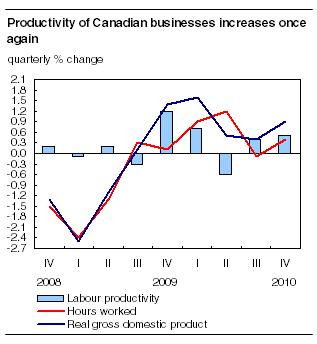Labour productivity, hourly compensation and unit labour cost
Archived Content
Information identified as archived is provided for reference, research or recordkeeping purposes. It is not subject to the Government of Canada Web Standards and has not been altered or updated since it was archived. Please "contact us" to request a format other than those available.
Related subjects
-
[an error occurred while processing this directive]
The labour productivity of Canadian businesses rose 0.5% in the fourth quarter, after advancing 0.4% the previous quarter.

Businesses boosted their real output (+0.9%) at a faster pace in the fourth quarter compared with the previous two quarters. Service-producing businesses were the main contributor to the growth. For the first time since the third quarter of 2009, growth in the output of the service sector outpaced that of the goods sector.
At the same time, hours worked rose 0.4%, after edging down 0.1% the previous quarter. Employment was unchanged in the fourth quarter, while hours worked per job grew by 0.4%.
Services-producing businesses were responsible for the overall increase in business productivity, as their productivity rose 0.8% during the quarter, led by retail trade (+2.1%), wholesale trade (+1.7%), and finance, insurance and real estate (+0.9%).
Productivity among goods-producing businesses declined 0.3% in the fourth quarter. Productivity decreases in manufacturing and construction were partly offset by productivity gains in mining, oil and gas extraction and utilities.
Business productivity was up 1.4% in 2010, after rising 0.4% in 2009. This was the largest annual advance since 2005. The 3.2% increased in the real gross domestic product of businesses was composed of the 1.4% increase in productivity and a 1.8% gain in hours worked. In contrast, there were sharp declines in business output (-4.0%) and hours worked (-4.4%) in 2009.
In the United States, the labour productivity of businesses increased 0.6% in the fourth quarter, the same rate as in the previous quarter. Productivity growth in the United States was 3.8% in 2010, a pace comparable with that in 2009.
Labour costs per unit of production rose 0.6% for Canadian businesses in the fourth quarter. This was similar to the increase in each of the previous two quarters (+0.5%).
Average compensation per hour worked once again grew faster than productivity, advancing 1.1% in the fourth quarter.
The average value of the Canadian dollar against the American currency rose 2.6% in the fourth quarter. Canadian unit labour costs measured in US dollars increased 3.2%, after falling by 0.6% in the third quarter.
By comparison, American businesses' unit labour costs edged down 0.1% in the fourth quarter, after remaining unchanged the previous quarter.
For 2010 as a whole, average hourly compensation grew at much the same pace in Canadian and American businesses. However, the somewhat stronger productivity performance in the United States widened the gap in labour costs per unit of production, which increased 0.6% in Canada and fell 1.5% in the United States. With the appreciation of the Canadian dollar in 2010, the gap became even wider, as Canadian unit labour costs in US dollars rose 11.1%.
The labour productivity figures for the fourth quarter, released today, were revised back to the first quarter of 2010.
Note: The term "productivity" in this release refers to labour productivity. For the purposes of this analysis, labour productivity and related variables cover the business sector only. Labour productivity is a measure of real gross domestic product (GDP) per hour worked. Unit labour cost is defined as the cost of workers' wages and benefits per unit of real GDP.
This release includes the current year (2010) revisions of Labour Force Survey estimates published on January 28. Revisions for the period from 1981 to the present will be incorporated with the June 2011 release of first quarter 2011 data. The 2010 revisions led to a 0.3 percentage-point downward revision in the annual growth rate of employment and hours worked for the entire economy.
Available on CANSIM: tables 383-0008 and 383-0012.
Definitions, data sources and methods: survey number 5042.
Additional tables and links to other releases from the national accounts can be found in the fourth quarter 2010 issue of Canadian Economic Accounts Quarterly Review, Vol. 9, no. 4 (13-010-X, free). This publication is now available from the Key resource module of our website under Publications.
Labour productivity, hourly compensation and unit labour cost data for the first quarter of 2011 will be released on June 10.
For more information, or to enquire about the concepts, methods or data quality of this release, contact the information officer (613-951-3640, iead-info-dcrd@statcan.gc.ca), Income and Expenditure Accounts Division.
- Date modified:
